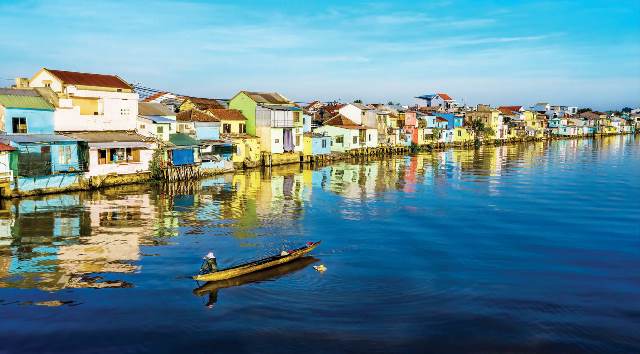Market on the river, warehouse on the shore
In the volume "Souvenirs of Hue", Duc Chaigneau wrote about what he saw in Hue in 1820, he called the port of Thanh Ha, Bao Vinh trading port. The road leading to the trading port was named Bao Vinh, and the Chinese had many shops filled with Chinese goods.
In particular, there were quite a lot of Chinese people, and they “did not mind doing a mediocre job, in the hope that through thrift, they would become shop owners like their compatriots one day.” They swept the streets, carried water or loads for traders, etc. “Many people even found animal bones in garbage piles to send back to China. Then the bones were made into toys for children, and they brought back to sell to Annamites.”

Bao Vinh was once a trading port
In the book "The Kingdom of Annam and the Annamites" in which Mr. Dutreuil de Rhins said that he came to the trading port of Bao Vinh in 1877, there are 2 notable details.
First, he saw many fortified houses whose “walls were built of stone, and this was a special feature against the floods frequently occurring from October to January.”
Second, he recognized a lot of precious goods being traded here: “Don't judge the book by its cover. Under the layers of mats and leaves covering the cabins of boats and other cheap goods were silk, pepper, ivory, sugar, cinnamon, nutmeg, bastard cardamom, smuggled opium, handicrafts made of elephant ivory, silver, bronze, and weapons, etc.”
These two details show that merchants at that time exchanged goods right on the river, and on the shore were solidly built warehouses (in the context that most of the houses at that time were thatched cottages).
The research work "Bao Vinh - the trading port of Hue" by Mr. R. Morineau (printed in B.A.V.H 1916) shows that by 1885, "The market on the land had lost all the brilliant beauty of the past. All the beautiful houses and large warehouses privately owned by the “illustrious” Chinese and Annamites had disappeared since 1885 when much of Bao Vinh was destroyed. The delicate flower garden of the family of the former Regent of the Annam court, i.e. the High Ranking Mandarin Tuong, now only has ruined walls.”
However, Bao Vinh was not completely wiped out in the year of 1885: "At that time, Bao Vinh was no longer in its golden time, but it was still one of the most important and beautiful markets in this region (after Hue market). Chinese, Japanese, Indian and European products can be found easily in Bao Vinh. It is possible to find commonly used items not being sold at Hue's flashy shops.”
He said that at night, the market on the land "had the character of an open-air flea market".
Types of boats that used to visit
The types of boats visiting Bao Vinh trading port at that time were recorded in quite detail. First were the tourist or commercial boats used in Indochina and China, as well as the modern motor boats.
Large and beautiful Chinese boats with deep bottoms, tall masts, and distinctively shaped sails ensured that the boats could go far and fast. This type of boat usually sailed from Shanghai to Singapore and stopped at Hue to deliver goods to large merchant ships.
Sometimes, other large boats also called in. He told me that there was once a very nice sailboat armed with four cannons and thirty Mauser rifles to fight pirates.
The Tonkinese boats from Mong Cai, the large sailboats owned by the owners in FaiFo, etc., were commercial ships that frequented several important ports. Boats designed completely with Annam’s features which were owned by people from Nam Dinh, Phan Ri, Quy Nhon, Da Nang, etc., carried Nam Dinh silk, carved tables and chairs inlaid with mother-of-pearl in Tonkin, Phat Diem mats, and South Central ceramics.
Each large boat was a floating shop, surrounded by many small boats approaching to trade. All boats, when leaving Bao Vinh, were loaded with goods to carry to China, Hong Kong, Hai Phong, Da Nang, etc., in which there were many products from Hue such as areca, Thanh Tra (Hue grapefruit), oranges, tangerines, products of Long Tho lime factory, rattan, bamboo and agarwood brought from the mountains.
Signals about the possible loss of Bao Vinh port
At the time when R. Morineau wrote about Bao Vinh trading port, there existed a railway in Hue (Hue Railway Station was built in 1906). Trains to Hue at that time carried a variety of goods to this city.
R. Morineau only saw the deterioration of the trading port of Bao Vinh when large sailing ships were forced to stop at Lai An, about 2km away, “to apply for paperwork at the tax station.”
But he hopes that the control of paper, which is necessary and worth doing, does not completely destroy Bao Vinh: “Because losing it means losing a beautiful area of Hue Ancient Capital”. R. Morineau still believes: “But anyway, Bao Vinh is also a warehouse for goods by waterway of Hue's commercial shops, a floating market for imports and exports, and moreover, a fun-filled center worthy of the attention from tourists”.
But the law of development did not follow the will of Mr. R. Morineau. When the boats were no longer moored in Bao Vinh, the shops naturally disappeared.
Meanwhile, Dong Ba new market next to Truong Tien Bridge began to prosper. Situated in a new location with favorable advantages "wharf on the river bank, boats on the water, together with crowded streets", Dong Ba market soon became the largest commercial center in the Citadel, positively influencing the economic and commercial development of Hue’s districts and towns as well as the central provinces.
The trading port of Bao Vinh then declined and disappeared, leaving many lessons in urban management.
Story: THANH NGOC. Photo: TUAN KIET